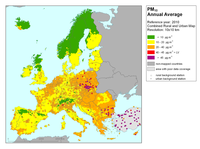
Output from conventional thermal power stations consists of gross electricity generation and also of any heat sold to third parties (combined heat and power plants) by conventional thermal public utility power stations as well as autoproducer thermal power stations.
The figure on the left is including district heat and the figure on the right is excluding district heat.
Left figure: Efficiency of conventional thermal electricity and heat production (including district heat).
Right figure: Efficiency of conventional thermal electricity and heat production (excluding district heat)

-

-

-

-

-

-

-

-

-

The map shows the exposure of European forest areas to ozone (AOT40), reference year 2010

The map shows the Ozone AOT40 for crops, reference year 2010

Trends in Direct material input (DMI) induced by household consumption, per Euro of expenditure in 12 household consumption (COICOP) categories, shown for 3 years 2000, 2004 and 2007. Emissions are based on the footprint perspective and include both emissions directly emitted by households (for example by burning fuels for heating) and emissions associated with the production of goods and services purchased by households.

Trends in emissions of tropospheric ozone precursors induced by household consumption, per Euro of expenditure in 12 household consumption (COICOP) categories, shown for 3 years 2000, 2004 and 2007. Emissions are based on the footprint perspective and include both emissions directly emitted by households (for example by burning fuels for heating) and emissions associated with the production of goods and services purchased by households.

Trends in acidifying emissions induced by household consumption, per Euro of expenditure in 12 household consumption (COICOP) categories, shown for 3 years 2000, 2004 and 2007. Emissions are based on the footprint perspective and include both emissions directly emitted by households (for example by burning fuels for heating) and emissions associated with the production of goods and services purchased by households.

Time series of companies in EU27 which are certified by ISO 14001

Time series of organisations and sites in EU27 which are registered to EMAS

Trends in greenhouse gas emissions induced by household consumption, per Euro of expenditure in 12 household consumption (COICOP) categories, shown for 3 years 2000, 2004 and 2007. Emissions are based on the footprint perspective and include both emissions directly emitted by households (for example by burning fuels for heating) and emissions associated with the production of goods and services purchased by households.

This figure shows stationwise trends in chlorophyll-a concentrations in coastal and open waters of the Baltic, North East Atlantic (Greater North Sea, Celtic Seas, Bay of Biscay), and Mediterranean Sea (Western Mediterranean Sea, Adriatic Sea) (% of stations showing statistically significant change, within the years 1985–2010). Numbers in parentheses indicates number of stations included in the analysis for each country. "Open sea" is the total of all off-shore stations (>20km) within a (sub)region.

The map shows stations with a statistically significant decrease (green), increase (red) or no trend (yellow) in winter ortophosphate concentrationswithin the period 1985-2010. Selected stations must have at least data in the period from 2007 to present and at least 5 years data in all.